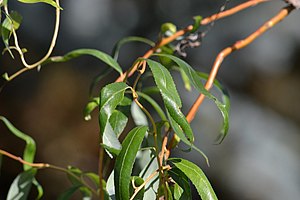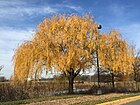Note: This is a project under development. The articles on this wiki are just being initiated and broadly incomplete. You can Help creating new pages.
Salix babylonica
Salix babylonica is a deciduous tree that can grow up to 12.00 metres tall. It is harvested from the wild for local use as a food, medicine and source of materials.
Contents
[hide]- 1 Uses
- 2 Parts Used
- 3 Chemical Composition
- 4 Common names
- 5 Properties
- 6 Habit
- 7 Identification
- 8 List of Ayurvedic medicine in which the herb is used
- 9 Where to get the saplings
- 10 Mode of Propagation
- 11 How to plant/cultivate
- 12 Commonly seen growing in areas
- 13 Photo Gallery
- 14 References
- 15 External Links
Uses
Abscesses, Carbuncle, Fever, Rheumatism, Skin diseases, Ulcers, Diarrhoea, Sores, Haemorrhages, Jaundice.[1]
Parts Used
Inner bark, Older leaves, Young shoots.
Chemical Composition
It contains anthelmintic, antiseptic, antiarthritic, astringent, analgesic, anticarcinogenic, antipyretic, antimalarial, antioxidant, antifungal, anthelmintic, and antibacterial, and these activities are related to the content of secondary compounds, such as the benzyl.[2]
Common names
| Language | Common name |
|---|---|
| Kannada | |
| Hindi | |
| Malayalam | |
| Tamil | |
| Telugu | |
| Marathi | |
| Gujarathi | |
| Punjabi | |
| Kashmiri | |
| Sanskrit | |
| English |
Properties
Reference: Dravya - Substance, Rasa - Taste, Guna - Qualities, Veerya - Potency, Vipaka - Post-digesion effect, Karma - Pharmacological activity, Prabhava - Therepeutics.
Dravya
Rasa
Guna
Veerya
Vipaka
Karma
Prabhava
Habit
Identification
Leaf
| Kind | Shape | Feature |
|---|---|---|
Flower
| Type | Size | Color and composition | Stamen | More information |
|---|---|---|---|---|
| {{{5}}} |
Fruit
| Type | Size | Mass | Appearance | Seeds | More information |
|---|---|---|---|---|---|
Other features
List of Ayurvedic medicine in which the herb is used
Where to get the saplings
Mode of Propagation
[[:Category:Index of Plants which can be propagated by |]], [[:Category:Index of Plants which can be propagated by |]], [[:Category:Index of Plants which can be propagated by |]].
How to plant/cultivate
Succeeds in most soils, including wet, ill-drained or intermittently flooded soils, but prefers a damp, heavy soil in a sunny position.[4]
Commonly seen growing in areas
[[:Category:Herbs that are commonly seen in the region of |]].
Photo Gallery
References
- Jump up ↑ Indian Medicinal Plants by C.P.Khare
- Jump up ↑ Chemical constituents
- Jump up ↑ [Morphology]
- Jump up ↑ Cultivation
External Links
- Ayurvedic Herbs known to be helpful to treat Abscesses
- Ayurvedic Herbs known to be helpful to treat Carbuncle
- Ayurvedic Herbs known to be helpful to treat Fever
- Ayurvedic Herbs known to be helpful to treat Rheumatism
- Ayurvedic Herbs known to be helpful to treat Skin diseases
- Ayurvedic Herbs known to be helpful to treat Ulcers
- Ayurvedic Herbs known to be helpful to treat Diarrhoea
- Ayurvedic Herbs known to be helpful to treat Sores
- Ayurvedic Herbs known to be helpful to treat Haemorrhages
- Ayurvedic Herbs known to be helpful to treat Jaundice
- Herbs with Inner bark used in medicine
- Herbs with Older leaves used in medicine
- Herbs with Young shoots used in medicine
- Habit - Deciduous tree
- Index of Plants which can be propagated by
- Herbs that are commonly seen in the region of
- Herbs




